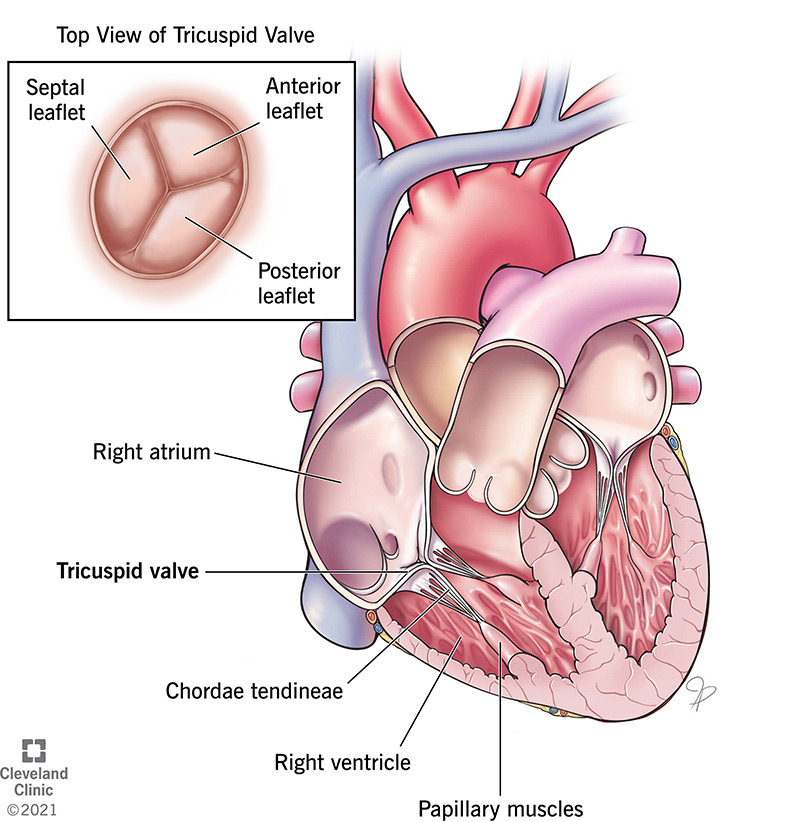The tricuspid valve is one of four heart valves. It helps blood flow in the correct direction from the right atrium to the right ventricle. Sometimes the tricuspid valve doesn’t function properly (for example, tricuspid regurgitation and tricuspid stenosis). The condition may need to be monitored, or you may require valve repair or replacement.
Advertisement
Cleveland Clinic is a non-profit academic medical center. Advertising on our site helps support our mission. We do not endorse non-Cleveland Clinic products or services. Policy

The tricuspid valve is one of four valves in the heart. It’s located between the right lower heart chamber (right ventricle) and the right upper heart chamber (right atrium).
Advertisement
Cleveland Clinic is a non-profit academic medical center. Advertising on our site helps support our mission. We do not endorse non-Cleveland Clinic products or services. Policy
The tricuspid valve opens and closes to ensure that blood flows in the correct direction. It’s also called the right atrioventricular valve.
The heart pumps blood in a specific route through four chambers (two atria and two ventricles). Every time your heart beats, the atria receive oxygen-poor blood from the body. And the ventricles contract (squeeze) to pump blood out.
As the heart pumps, valves open and close to allow blood to move from one area of the heart to another. The valves help ensure that blood flows at the right time and in the correct direction.
The tricuspid valve ensures that blood flows from the right atrium to the right ventricle. It also prevents blood from flowing backward between those two chambers. When the right atrium fills, the tricuspid valve opens, letting blood into the right ventricle. Then the right ventricle contracts to send blood to the lungs. The tricuspid valve closes tightly so that blood does not go backward into the right atrium.
The tricuspid valve is located between the right lower heart chamber (right ventricle) and the right upper heart chamber (right atrium). It’s positioned vertically (up and down).
The tricuspid valve is made of three thin but strong flaps of tissue. They’re called leaflets or cusps. The leaflets are named by their positions: anterior, posterior and septal. They attach to the papillary muscles of the ventricle with thin, strong cords called chordae tendineae.
Advertisement
With every heartbeat, those leaflets open and close. The sounds of the heart valves opening and closing are the sounds you hear in a heartbeat.
If the tricuspid valve isn’t functioning as it should, blood may not flow efficiently in the correct direction or it may leak in the wrong direction. Your heart may have to work harder to pump enough blood to the rest of your body.
There are three main types of tricuspid valve problems:
Several factors can cause problems with the tricuspid valve, including:
When the tricuspid valve isn’t functioning normally, your heart might have to work harder to pump blood. This can lead to fatigue and weakness.
If a tricuspid condition gets worse over time, it can also cause:
If a healthcare provider suspects you have a problem with the tricuspid valve, you may need a cardiologist. A cardiologist is a doctor who specializes in diagnosing and treating heart problems.
Several tests can help examine the tricuspid valve:
Advertisement
A tricuspid valve condition may require treatment or continued monitoring depending on the severity of your valve problem and your symptoms.
If treatment is warranted, your healthcare provider may recommend:
If you have a tricuspid valve condition, you can help keep your heart healthier and prevent complications with these strategies:
Advertisement
If you have a tricuspid valve problem, you should immediately report any signs of infection. This will help you catch and treat endocarditis (heart infection) early. Call your healthcare provider right away if you have signs of infection, such as body aches, fever or sore throat. You should also attend all appointments to have your heart checked regularly.
The tricuspid valve is one of four heart valves. It ensures that blood flows from the right atrium to the right ventricle at the right time and in the right direction. If the tricuspid valve isn’t working properly, your healthcare provider may recommend regular checkups or surgery to repair or replace the faulty valve.
Advertisement
Problems with your heart can be scary. Our experts can diagnose and treat mitral & tricuspid heart valve disease.

Last reviewed on 09/15/2021.
Learn more about the Health Library and our editorial process.